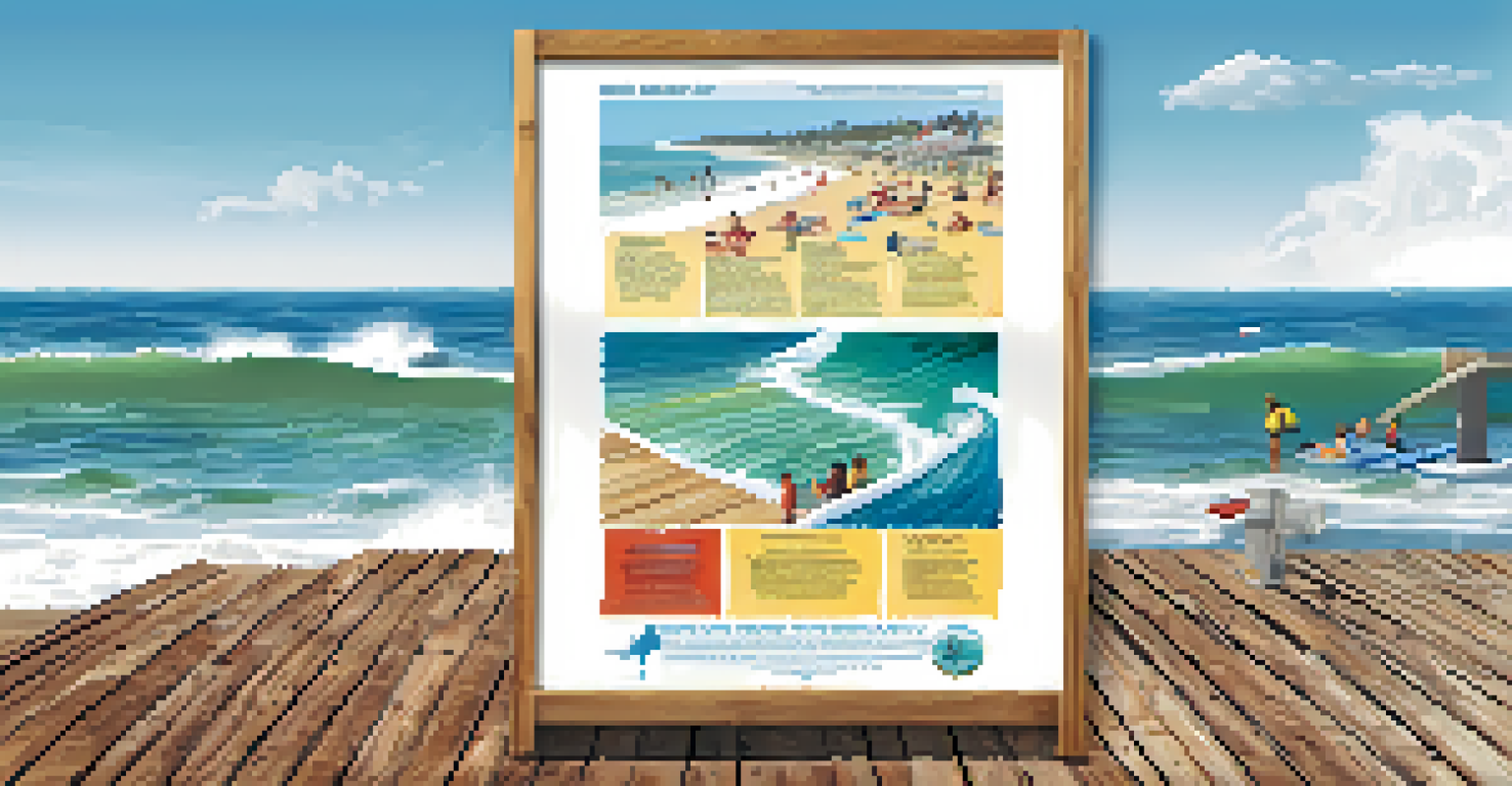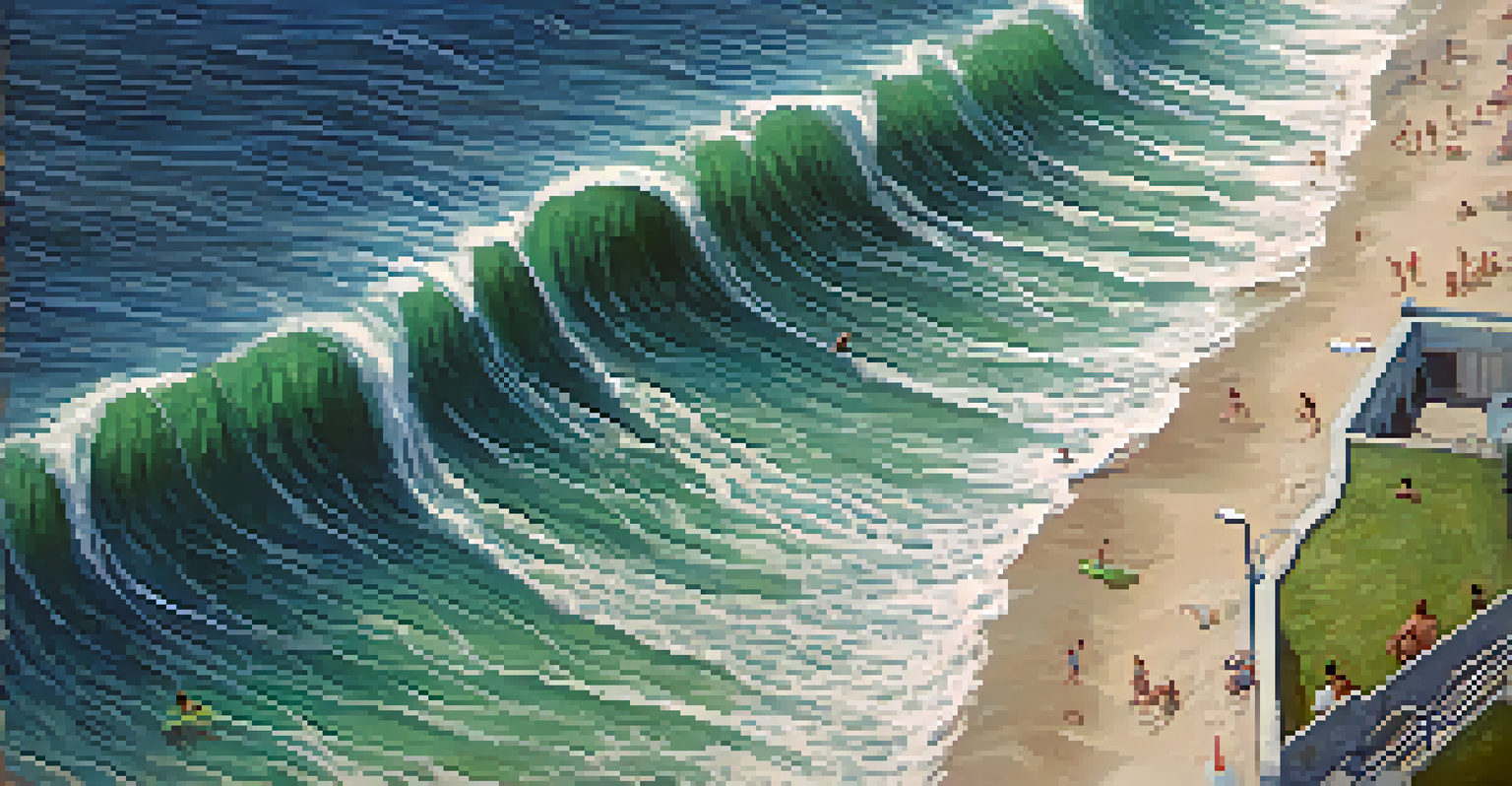Understanding Rip Currents: A Guide for Santa Monica Residents

What Are Rip Currents and How Do They Form?
Rip currents are powerful, narrow channels of water that flow away from the shore. They occur when waves break over sandbars or near structures like piers, forcing water to return to the ocean. This water escapes through these channels, creating a swift current that can be dangerous for swimmers.
The ocean stirs the heart, inspires the imagination, and brings eternal joy to the soul.
These currents can happen at any beach, including Santa Monica, and can occur suddenly, even on calm days. Understanding how rip currents form is crucial for beachgoers, as it helps in identifying potential dangers. The more informed you are, the better prepared you'll be when enjoying the waves.
By looking for signs like choppy water, differences in water color, or foam moving away from the shore, you can gain insight into where rip currents might be present. It’s essential to stay vigilant and educate yourself about these natural occurrences to ensure a safe beach experience.
Recognizing the Signs of Rip Currents
Spotting a rip current can be a matter of life and death. Look for areas where the water is murky, or where waves are breaking less consistently. These can be indicators of a rip current, as the water flows out to sea in a narrow path.

Another telltale sign is the presence of foam and debris moving away from the shore. If you see these signs, it’s best to avoid that area and choose a safer place to swim. Awareness is key, and knowing what to look for can make all the difference.
Understanding Rip Currents
Rip currents are dangerous channels of water that can form suddenly and pull swimmers away from the shore.
It's also helpful to pay attention to local lifeguards and any posted warnings. They are trained to identify these currents and can provide valuable information about swimming conditions. Always listen to their advice to ensure your safety while enjoying the beach.
The Dangers of Rip Currents for Swimmers
Rip currents pose serious risks, especially for inexperienced swimmers. They can pull even strong swimmers out to deeper water, leading to panic and exhaustion. Understanding this danger is vital for anyone who enjoys the ocean.
In every outthrust headland, in every curving bay, in every grain of sand there is the story of the earth.
Statistics show that rip currents are responsible for many rescues at beaches. Knowing how to swim in the ocean can protect you from becoming a statistic. It’s not just about enjoying the water; it’s also about respecting its power.
Panic often sets in when caught in a rip current, which can lead to poor decisions. Instead of fighting the current, it’s essential to remain calm and swim parallel to the shore until you’re free of the current's grip. This knowledge can empower swimmers and help them navigate the waves safely.
How to Stay Safe from Rip Currents
Staying safe from rip currents starts with understanding your surroundings. Always swim at a beach with lifeguards present and heed any warning flags. This proactive approach can significantly reduce your risk while enjoying the ocean.
If you find yourself caught in a rip current, remember to stay calm. Swim parallel to the shore until you're free of the current, then head back to the beach. This technique can be a lifesaver, as it allows you to escape the pull without exhausting yourself.
Recognizing Warning Signs
Identifying signs like choppy water and foam can help beachgoers spot rip currents and avoid dangerous areas.
Additionally, educating friends and family about rip currents can create a safer beach environment. Sharing knowledge about how to recognize and respond to rip currents helps keep everyone safe and ensures a fun day at the beach.
The Importance of Swimming with a Buddy
One of the best ways to enhance safety at the beach is to swim with a buddy. Having someone with you not only makes swimming more enjoyable but also provides an extra layer of safety. If one of you gets into trouble, the other can assist or call for help.
When swimming together, it’s easier to keep an eye on each other and spot any potential dangers, including rip currents. This camaraderie fosters a sense of responsibility, making you more aware of your surroundings and each other’s well-being.
So, next time you're considering a beach day, remember: the buddy system isn't just for kids on the playground. It’s a practical way to stay safe while making memories along the beautiful Santa Monica shoreline.
What to Do if You See Someone in Trouble
If you ever witness someone struggling in a rip current, your immediate reaction can be crucial. First, shout to them to swim parallel to the shore, as this is often the best way to escape. Encourage them to remain calm, as panic can lead to exhaustion.
If they're unable to reach safety, it’s important to alert a lifeguard immediately. They are trained to handle these situations and can quickly and effectively respond. Calling for help can save a life, so never hesitate to take action.
Safety Tips for Swimmers
Swimming with a buddy and knowing how to respond if caught in a rip current are essential for beach safety.
In some cases, if you’re a strong swimmer, you may consider attempting a rescue yourself. However, remember that your safety is paramount. If the situation is too dangerous, it's better to wait for trained professionals to arrive than to put yourself at risk.
Resources for Santa Monica Beach Safety
Staying informed about beach safety can make all the difference when enjoying Santa Monica's beautiful coastline. Local agencies, like the Santa Monica Lifeguards, provide invaluable resources and information about current swimming conditions and safety tips.
You can also find helpful materials on rip currents through organizations such as the National Oceanic and Atmospheric Administration (NOAA). They offer educational resources that explain how to recognize and respond to rip currents effectively.

Lastly, consider attending community beach safety workshops or events. These gatherings provide hands-on experience and knowledge, ensuring you’re well-prepared for a fun and safe day at the beach. Knowledge is your best defense against the ocean's unpredictable nature.